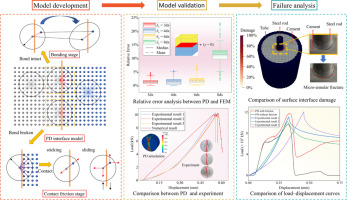Interface mechanical behavior significantly affects the structural integrity of composites and the reliability of engineering systems, with contact friction being a key contributor to interface failure. To investigate the failure mechanisms of material interfaces, this study develops a coupled bonding-contact friction peridynamics (PD) interface model. The bond-based PD is employed to describe the bonding and debonding processes. For characterizing contact friction, a three-dimensional nonlocal contact friction model is proposed to capture the friction behavior following debonding. The model incorporates long-range forces to account for spatially distributed contact effects, enabling accurate representation of interface behavior during both sticking and sliding contact friction stages. The contact friction model is verified through a two-block sliding model and Brazilian splitting experiments. Results show that the PD simulations exhibit close agreement with the finite element method (FEM) and experimental results. Combined with the classical microbond test, the applicability of the proposed model across different scales in the entire interface failure process is confirmed. Accounting for friction reduces the error in simulating peak pull-out force from 20.8 % to 1.3 %. In addition, a steel rod-cement interface debonding experimental model is designed. By comparing simulation results with experimental data, the error in predicting the peak load is reduced from 12.9 % to 6 % when friction is included. Furthermore, including friction enables accurate representation of the bonding and friction evolution during interface failure. This study provides an effective method for characterizing bonding and friction mechanisms during interface failure, with potential engineering application value.

Article link: https://www.sciencedirect.com/science/article/pii/S0020740325005612





 Address
Address
 E-Mail
E-Mail
 Telephone
Telephone